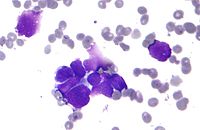
Photo from wikipedia
Background Hepatocellular carcinoma (HCC) is one of the most common global malignancies with increasing morbidity and mortality. The purpose of this study was to investigate the expression levels and prognostic… Click to show full abstract
Background Hepatocellular carcinoma (HCC) is one of the most common global malignancies with increasing morbidity and mortality. The purpose of this study was to investigate the expression levels and prognostic value of microRNA-3607 (miR-3607) in patients with HCC. Methods The expression of miR-3607 was estimated by quantitative real-time RT-PCR. Survival analysis using the Kaplan-Meier method and Cox regression analysis was conducted to evaluate the prognostic value of miR-3607. The functional role of miR-3607 in HCC progression was further assessed using gain- and loss-of-function experiments. Bioinformatics analysis and a dual-luciferase reporter assay were used to explore the direct targets of miR-3607. Results miR-3607 expression was found to be significantly decreased in HCC tissues and cells compared with the matched tissues and cells ( P < 0.001). The decreased expression of miR-3607 was associated with the patients’ tumor size and TNM stage (all P < 0.05). According to the survival curves, patients with low miR-3607 expression had poorer overall survival than those with high levels (log-rank P = 0.012). Moreover, the Cox analysis results indicated that miR-3607 expression was an independent prognostic factor for HCC. The results of cell experiments revealed that the overexpression of miR-3607 in HCC cells led to the inhibited cell proliferation, migration, and invasion. TGFBR1 was identified as a direct target of miR-3607. Conclusion The data of this study indicated that the decreased expression of miR-3607 in HCC predicts poor prognosis and the overexpression of miR-3607 in HCC cells can suppress the tumor progression by targeting TGFBR1 . This study provides a novel insight into the prognosis and treatment of HCC, and miR-3607 serves as a candidate prognostic biomarker and therapeutic target of HCC.
Journal Title: Diagnostic Pathology
Year Published: 2020
Link to full text (if available)
Share on Social Media: Sign Up to like & get
recommendations!